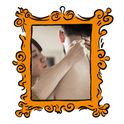If one of the aims of an artist is to reveal aspects of humanity to the viewer, then Paula Rego favours the dark side. For more than 70 years she has explored—obsessively, some might say—the hidden motivations that underpin human behaviour.
In Tate Britain’s current retrospective, which runs until 24th October, the earliest canvas dates from 1950 when Rego was just 15. Titled Interrogation, it shows a young girl, head bowed, body contorted by fear, sitting between two faceless men. Among the last canvases in the show is a series Rego made between 2007-2009 about female genital mutilation. The characters in these FGM paintings look oddly jaunty, both victims and perpetrators sometimes resembling dolls, or the kind of caricatures that might accompany a Dickens novel. Like Dickens, like Picasso, Rego sees horror as part of life’s carnival. Her artistic disquisitions—often inspired by the news, but also by books, philosophy and plays—are drawn from a colourful palette, canvases imbued with the Iberian warmth of her upbringing in Portugal.
It’s that disconcerting distance between surface and subtext that makes her work so compelling. One of the most distinctive voices in British art, Rego ought to be as admired as David Hockney, also in his eighties and currently the subject of a major London show—but she isn’t. Perhaps the facts that she is Portuguese-born, and a woman, complicate our affiliation. Even when resident in California or France, Hockney is recognisably a Yorkshireman. Rego’s unwillingness to “belong” anywhere, except the studio, makes her harder to embrace. She would rather be an outsider.
She was born in Lisbon in 1935, two years into the “Estado Novo,” the corporatist, conservative dictatorship of António de Oliveira Salazar that was to prove such a spur to her work, and which lasted until the Carnation Revolution of 1974. Under Salazar’s regime, wealthy families, the military and the church were favoured while most of the population was kept poor and illiterate. A ruthless secret police force suppressed any opposition. In 1936, Rego’s father, an engineer who worked for Marconi, moved with his wife to Britain for training, leaving her in the care of a grandmother and an aunt, who would tell her traditional stories. Gabriel García Márquez has credited his own grandmother’s stories with shaping his creativity, and the same seems to have been the case for Rego. Some of the stories she was told were properly terrifying: in one of them, a woodcutter’s wife cuts off her own breasts, cooks them and serves them to the family when they run out of food. It would be hard to think of a more gruesome metaphor for female self-sacrifice.
Rego went to a British school in Lisbon and in 1951 her father sent her to a finishing school in Kent. From there she got into the Slade School of Art, where daily life-drawing classes were part of the rigorous training. Rego won the prestigious Slade Summer Prize for a painting that transported Dylan Thomas’s Under Milk Wood to Portugal (she already thought of herself as a “storytelling artist”). But Rego didn’t entirely take to the Slade’s purist methods. She preferred the French artist Jean Dubuffet, a proponent of “low art” and popular culture. Dubuffet “really gave her the freedom to experiment again, to return to something that was more connected to childhood, to scribbles, to expressing things in a much rawer, more intense way,” says Elena Crippa, curator of modern and contemporary British art at the Tate. “She consciously wanted to operate outside the boundaries of what was seen as ‘fine’ art.”
Rego’s works from the 1960s are provocations, including Salazar Vomiting the Homeland and When We Had a House in the Country We’d Throw Marvellous PartiesandThen We’d Go Out and Shoot Black People (the latter an observation of a Portuguese colonialist overheard in a Lisbon club). These highly abstract compositions incorporate collage, cuttings from adverts or populist newspapers alongside the carnivalesque and grotesque elements that have remained in her art to this day. It’s impossible to know what the “story” is in these pieces without reference to the title.
“Rego illustrates menace and the abuse of power both in government and in the home”
At the Slade she had fallen in love with a fellow student, Victor Willing. After Rego got pregnant, she decided to keep the baby and returned to Portugal, but Willing soon followed. After his divorce he and Rego married and had two more children. For a time their lives were split between London and Portugal, where Rego’s parents could support them but eventually—after her father’s death and the failure of the family business—the couple settled in London full time. Family, art and money proved difficult to juggle. There were affairs on both sides, alluded to in canvases Rego has previously been reluctant to decipher but now acknowledges as being about these deceptions (although a title like Wife Cuts off Red Monkey’s Tail perhaps doesn’t require much deciphering). The pictures are sketches in paint, funny-angry responses to betrayal, and for the first time they use animals to represent humans, an innovation Rego stuck with and, in the last phase of her career, has used more than ever.
The animal characters were originally suggested by Willing’s puppet theatre (“The animals were his but what happened to them was mine,” Rego has said) but their significance may owe more to her Jungian therapy, with its emphasis on archetype and myth. Rego has suffered with depression her whole life; her first analyst was the psychiatrist Anthony Storr, whose work centres on the ways aggression, destructiveness and sexual deviance, can be both unseen motivations and engines of creativity. Rego used her own experiences to explore how such behaviour operates in society and in families. In 1966, Willing had been diagnosed with multiple sclerosis and Rego increasingly needed to be his carer. The power dynamic between the couple became more complicated.
The dictator Salazar once observed that “the Portuguese must be treated as children: too much too often would spoil them.” But children tend to rebel, and it’s by subverting the language of childhood that Rego most effectively illustrates menace and the abuse of power both in government and in the home. In several paintings of a girl and a dog, it’s hard to decide whether the girl is playing with her pet or tormenting it. “I was always being repressed and restrained by my mother, not Salazar,” she has said. “Maybe the authoritarian thing comes right through to the kid, who takes it out on the dog or the doll.”
The 1980s saw a return to more formal figurative painting. Grants from the Calouste Gulbenkian Foundation bought Rego security and confidence and she began creating more recognisable, if oblique, scenarios. Often they take place in what looks like a nursery, with toys scattered in the foreground—a tin soldier references colonialist wars—while fortresses in the background suggest the presence of oppressive forces.
These large canvases would form the basis of Rego’s first retrospective at London’s Serpentine Gallery in 1988 and still constitute her most famous work. Her characters are surprisingly solid women and girls, almost monumental, in the style of Picasso’s cubist figures. They seem to be caught in the act of some unknown cruelty. The Family (1988) shows a woman and daughter helping a man to undress while another daughter watches, clasping or rubbing her hands. It looks like a scene of abuse. The man is muzzled by his wife’s arm across his face. The daughter presses herself between his legs. Yet, the painting’s original title was “Lazarus.” The man’s status or possibilities seem to have changed in the course of the canvas’s painting.
“Paula isn’t a traditional painter in that when she starts something she doesn’t necessarily know where it’s heading,” says Crippa, “but Family is clearly a reference to Vic [Willing], who was almost paralysed by this time. A debilitated person is at the mercy of others.”
In The Policeman’s Daughter (1987, centre), a girl polishes her father’s boot, her hand shoved inside it, elbow deep. The inspiration here, says Crippa, was Robert Mapplethorpe’s graphic portrait Fist Fuck. Is the girl screwing authority—or enacting it? As so often with Rego, it’s hard to tell. According to her son Nick Willing, “All her pictures are cryptograms in some way or another.”
The largest canvas from this time, The Dance (see opening spread), features dancers on a Portuguese beach, with a fortress-style building—in fact a former prison—in the background. Showing a group of people in the light of a full moon, it’s perhaps Rego’s best-loved painting, but here, as elsewhere, the subtext is more complicated. Willing appears twice, in one corner dancing with Rego and then near the centre with a blonde lover. Rego is also seen dancing a second time, on her own, as indeed she was by the time the painting was finished. Willing had died before it could be completed, and it wasn’t ready in time for the Serpentine retrospective. When Rego returned to The Dance, Nick posed for the part of his father. Her children have often served as Rego’s models although, as Crippa points out, more often out of convenience than inspiration.

“Lots of artists’ children will tell you that one of the few ways to engage with a parent who’s obsessively working on art is to become interested and step into their world. Also, they were people that she could observe all the time. She wouldn’t ask them to sit for a painting; she made life drawings which would later be transposed into the painting.”
Rego’s most regular sitter, though, was Lila Nunes, who first came from Portugal to help care for Willing and later combined the roles of artist’s model, muse and collaborator. Nunes still sits for Rego and her face and body are in many of the artist’s most powerful pictures, such as the crouching, snarling Dog Woman and the Possession series—never before shown in the UK—inspired by 19th-century medical studies of hysteria. For these Nunes took up positions on a psychoanalyst’s couch, the same one that had belonged to Rego’s own analyst—a particularly close alliance of life and art.
The most affecting series in the Tate exhibition depicts women in the aftermath of illegal abortions. The paintings were made in a spirit of campaigning fury, after a 1998 referendum in Portugal decided against legalising abortion. Women and girls, one in her school uniform, are shown curled up in pain, or crouched uncomfortably over bowls. “She’s spoken of her own experience of poor women coming to the house [in Portugal] asking for money,” says Crippa. “The rich women could afford to fly to Switzerland, the poor ones had to submit to illegal, dangerous procedures.”
The canvases were shown as soon as they were finished, in 1999, in Madrid and Lisbon. Ten years later both Spain and Portugal had legalised abortion. Rego made the pictures in oil pastels, allowing a more direct route from feeling to page. Paint, she said, was “too lyrical,” whereas she preferred an attacking style. “I’m not a painter really. I’m a drawer. I draw a lot. I don’t like it when you paint and the brush bends. When you draw you can push your pencil or your pastel—everything is much more violent.”
And violence is the key. In 1909 the Futurist Manifesto proclaimed: “there is no masterpiece that has not an aggressive character.” While violence, in art as in life, is often seen as a corollary of youth, with Rego, 70 years on from Interrogation, it is undiminished. Not for her the gentle depiction of a Normandy spring. Her most recent works take on the devastation of war in Iraq, human trafficking and the crushing effects of clinical depression. At 82, she made drawings of herself after a fall—unflinching, frightening studies of old age and frailty that she opted not to include in this exhibition. Whatever she seeks to resolve, Rego hasn’t yet found the answer. That continuing quest still gives her work a startling energy.












